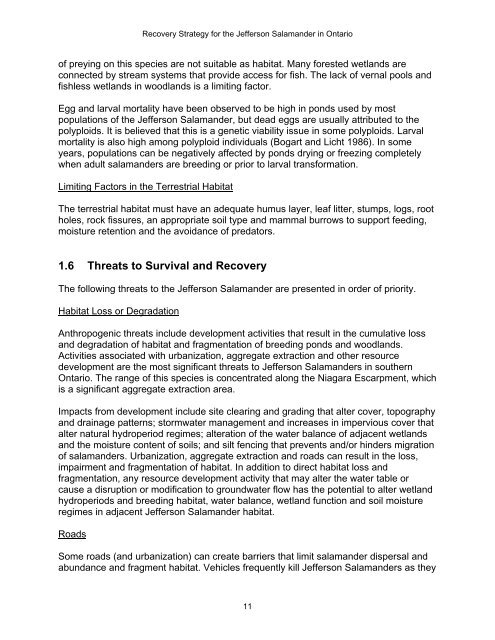Jefferson Salamander - Amphibian Specialist Group
Jefferson Salamander - Amphibian Specialist Group
Jefferson Salamander - Amphibian Specialist Group
Create successful ePaper yourself
Turn your PDF publications into a flip-book with our unique Google optimized e-Paper software.
Recovery Strategy for the <strong>Jefferson</strong> <strong>Salamander</strong> in Ontarioof preying on this species are not suitable as habitat. Many forested wetlands areconnected by stream systems that provide access for fish. The lack of vernal pools andfishless wetlands in woodlands is a limiting factor.Egg and larval mortality have been observed to be high in ponds used by mostpopulations of the <strong>Jefferson</strong> <strong>Salamander</strong>, but dead eggs are usually attributed to thepolyploids. It is believed that this is a genetic viability issue in some polyploids. Larvalmortality is also high among polyploid individuals (Bogart and Licht 1986). In someyears, populations can be negatively affected by ponds drying or freezing completelywhen adult salamanders are breeding or prior to larval transformation.Limiting Factors in the Terrestrial HabitatThe terrestrial habitat must have an adequate humus layer, leaf litter, stumps, logs, rootholes, rock fissures, an appropriate soil type and mammal burrows to support feeding,moisture retention and the avoidance of predators.1.6 Threats to Survival and RecoveryThe following threats to the <strong>Jefferson</strong> <strong>Salamander</strong> are presented in order of priority.Habitat Loss or DegradationAnthropogenic threats include development activities that result in the cumulative lossand degradation of habitat and fragmentation of breeding ponds and woodlands.Activities associated with urbanization, aggregate extraction and other resourcedevelopment are the most significant threats to <strong>Jefferson</strong> <strong>Salamander</strong>s in southernOntario. The range of this species is concentrated along the Niagara Escarpment, whichis a significant aggregate extraction area.Impacts from development include site clearing and grading that alter cover, topographyand drainage patterns; stormwater management and increases in impervious cover thatalter natural hydroperiod regimes; alteration of the water balance of adjacent wetlandsand the moisture content of soils; and silt fencing that prevents and/or hinders migrationof salamanders. Urbanization, aggregate extraction and roads can result in the loss,impairment and fragmentation of habitat. In addition to direct habitat loss andfragmentation, any resource development activity that may alter the water table orcause a disruption or modification to groundwater flow has the potential to alter wetlandhydroperiods and breeding habitat, water balance, wetland function and soil moistureregimes in adjacent <strong>Jefferson</strong> <strong>Salamander</strong> habitat.RoadsSome roads (and urbanization) can create barriers that limit salamander dispersal andabundance and fragment habitat. Vehicles frequently kill <strong>Jefferson</strong> <strong>Salamander</strong>s as they11
















